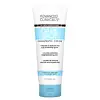What's inside
What's inside
 Key Ingredients
Key Ingredients

 Benefits
Benefits

 Concerns
Concerns

 Ingredients Side-by-side
Ingredients Side-by-side

Aloe Barbadensis Leaf Juice
Skin ConditioningStearic Acid
CleansingGlycerin
HumectantGlyceryl Stearate Se
EmulsifyingCocos Nucifera Oil
MaskingGlyceryl Stearate
EmollientPEG-100 Stearate
Beeswax
Emulsion StabilisingBehenyl Alcohol
EmollientCetyl Alcohol
EmollientAminopropyl Ascorbyl Phosphate
AntioxidantDipotassium Glycyrrhizate
HumectantSimmondsia Chinensis Seed Oil
EmollientButyrospermum Parkii Butter
Skin ConditioningCetearyl Dimethicone
EmollientXanthan Gum
EmulsifyingDisodium EDTA
Sodium Hydroxide
BufferingParfum
MaskingEthylhexylglycerin
Skin ConditioningCaprylyl Glycol
EmollientHexylene Glycol
EmulsifyingPhenoxyethanol
PreservativeAloe Barbadensis Leaf Juice, Stearic Acid, Glycerin, Glyceryl Stearate Se, Cocos Nucifera Oil, Glyceryl Stearate, PEG-100 Stearate, Beeswax, Behenyl Alcohol, Cetyl Alcohol, Aminopropyl Ascorbyl Phosphate, Dipotassium Glycyrrhizate, Simmondsia Chinensis Seed Oil, Butyrospermum Parkii Butter, Cetearyl Dimethicone, Xanthan Gum, Disodium EDTA, Sodium Hydroxide, Parfum, Ethylhexylglycerin, Caprylyl Glycol, Hexylene Glycol, Phenoxyethanol
Water
Skin ConditioningSodium Hyaluronate
HumectantPentylene Glycol
Skin ConditioningPropanediol
SolventSodium Hyaluronate Crosspolymer
HumectantPanthenol
Skin ConditioningAhnfeltia Concinna Extract
Skin ConditioningGlycerin
HumectantTrisodium Ethylenediamine Disuccinate
Citric Acid
BufferingIsoceteth-20
EmulsifyingEthoxydiglycol
HumectantEthylhexylglycerin
Skin ConditioningHexylene Glycol
Emulsifying1,2-Hexanediol
Skin ConditioningPhenoxyethanol
PreservativeCaprylyl Glycol
EmollientWater, Sodium Hyaluronate, Pentylene Glycol, Propanediol, Sodium Hyaluronate Crosspolymer, Panthenol, Ahnfeltia Concinna Extract, Glycerin, Trisodium Ethylenediamine Disuccinate, Citric Acid, Isoceteth-20, Ethoxydiglycol, Ethylhexylglycerin, Hexylene Glycol, 1,2-Hexanediol, Phenoxyethanol, Caprylyl Glycol
 Reviews
Reviews

Alternatives
Ingredients Explained
These ingredients are found in both products.
Ingredients higher up in an ingredient list are typically present in a larger amount.
Caprylyl Glycol is a humectant and emollient, meaning it attracts and preserves moisture.
It is a common ingredient in many products, especially those designed to hydrate skin. The primary benefits are retaining moisture, skin softening, and promoting a healthy skin barrier.
Though Caprylyl Glycol is an alcohol derived from fatty acids, it is not the kind that can dry out skin.
This ingredient is also used as a preservative to extend the life of products. It has slight antimicrobial properties.
Learn more about Caprylyl GlycolEthylhexylglycerin (we can't pronounce this either) is commonly used as a preservative and skin softener. It is derived from glyceryl.
You might see Ethylhexylglycerin often paired with other preservatives such as phenoxyethanol. Ethylhexylglycerin has been found to increase the effectiveness of these other preservatives.
Glycerin is already naturally found in your skin. It helps moisturize and protect your skin.
A study from 2016 found glycerin to be more effective as a humectant than AHAs and hyaluronic acid.
As a humectant, it helps the skin stay hydrated by pulling moisture to your skin. The low molecular weight of glycerin allows it to pull moisture into the deeper layers of your skin.
Hydrated skin improves your skin barrier; Your skin barrier helps protect against irritants and bacteria.
Glycerin has also been found to have antimicrobial and antiviral properties. Due to these properties, glycerin is often used in wound and burn treatments.
In cosmetics, glycerin is usually derived from plants such as soybean or palm. However, it can also be sourced from animals, such as tallow or animal fat.
This ingredient is organic, colorless, odorless, and non-toxic.
Glycerin is the name for this ingredient in American English. British English uses Glycerol/Glycerine.
Learn more about GlycerinHexylene Glycol is a surfactant. Glycols are a class of alcohols. Hexylene Glycol is a surfactant and emulsifier.
As a surfactant, Hexylene Glycol helps gather dirt and oil on your skin to be washed away.
As an emulsifier, Hexylene Glycol helps keep water and oil together. This prevents them from separating in a product. Hexylene Glycol also thins out the texture of a product by lessening viscosity.
Hexylene Glycol has a small molecular weight.
Learn more about Hexylene GlycolPhenoxyethanol is a preservative that has germicide, antimicrobial, and aromatic properties. Studies show that phenoxyethanol can prevent microbial growth. By itself, it has a scent that is similar to that of a rose.
It's often used in formulations along with Caprylyl Glycol to preserve the shelf life of products.